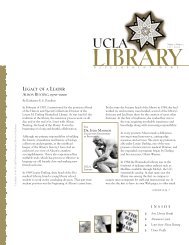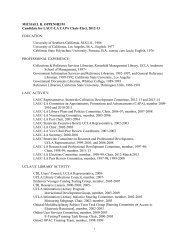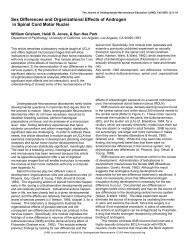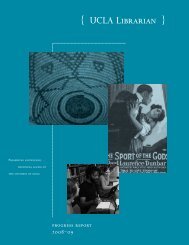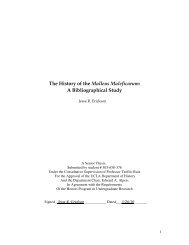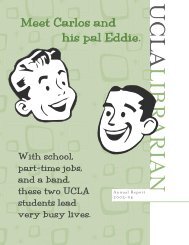Research Paper - UCLA Library
Research Paper - UCLA Library
Research Paper - UCLA Library
You also want an ePaper? Increase the reach of your titles
YUMPU automatically turns print PDFs into web optimized ePapers that Google loves.
and Fletcher’s purpose of endowing James with his predecessor’s authority. The phoenix trope<br />
thus factors heavily in the imagery of the final seventeen lines of Cranmer’s monologue, which<br />
shift from the accomplishments of her reign to the queen’s posthumous legacy. The duke<br />
prophesizes that when “the bird of wonder dies, the maiden phoenix,/ Her ashes new create<br />
another heir/ As great in admiration as herself” (V.4.40-42). At the moment of her birth in the<br />
Gu 32<br />
play, the court is already looking towards Elizabeth’s death. In the late 1590s, towards the end of<br />
the historical reign of Queen Elizabeth, public concern grew over who would succeed the<br />
childless aging queen. Despite the proliferation of sonnets and other poetry in praise of the<br />
queen, underlying cultural tensions festered as the English people worried about factional<br />
struggle and civil war if no clear heir was named when Elizabeth died. Shakespeare and Fletcher<br />
avoid this ambivalence by addressing the succession issue as soon as the princess is born in the<br />
play. The play acknowledges that Elizabeth never actually biologically gives birth to an heir;<br />
instead “her ashes new create another heir” (V.4.41). The phoenix imagery is especially powerful<br />
as a portrayal of asexual regeneration in which the essence of Elizabeth becomes manifested in<br />
her successor. 11 As in Hooke’s sermon, all of the virtues described in the virgin monarch are thus<br />
transferred to James: “Peace, plenty, love, truth, terror,/ That were the servants to this chosen<br />
infant,/ Shall then be his” (V.4.47-49). In Henry VIII, the infant Elizabeth overpowers the king’s<br />
legacy as the shining moment of glory for Henry in the play is the birth of his daughter; and yet,<br />
this event is also overshadowed by the looming presence of James in the concluding lines of the<br />
play.<br />
What first appears as a simple glorification of the deceased queen turns into praise and<br />
hope for the reigning monarch for whom history had not yet been written. The play reckons back<br />
11 For more reading on maternal imagery in Henry VIII, see Jo Eldridge Carney’s essay “Queenship in<br />
Shakespeare’s Henry VIII: The Issue of Issue,” and Helen Hackett’s essay “‘Gracious be the issue’: maternity and<br />
narrative in Shakespeare’s late plays.”



